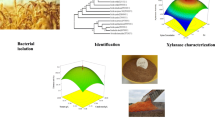Summary
A 32 central composite experimental design was performed with the aim of optimizing xylanase production by Thermomyces lanuginosus grown on corn cobs in submerged cultures. Xylanase production was first tested on different nitrogen sources (tomato skin, tomato seed meal, corn steep liquor, meat peptone, bacto-tryptone and yeast extract). Tomato seed meal was the selected substrate to test the effect of two variables on xylanase production (corn cobs and tomato seed meal concentrations). A second-order quadratic model and a response surface method showed that the optimum condition for xylanase production was corn cobs 4.6% (w/v) and tomato seed meal 2.1% (w/v). The optimum conditions found were transferred to 7-l bioreactors, where activities as high as 1630 U/ml were obtained.
Similar content being viewed by others
References
Abdel-Rahman A.Y. 1982 The chemical constituents of tomato seeds Food Chemistry 9: 315–318
Al-Wandawi H., Abdul-Rahman M., Al-Shainkhly K. 1985 Tomato processing wastes as essential raw materials source Journal of Agricultural and Food Chemistry 33: 804–807
Ammerman C.B., Arrington L.R., Loggins P.E., McCall J.T., Davis G.K. 1963 Nutritive value of dried tomato pulp for ruminants Journal of Agricultural and Food Chemistry 11: 347–349
Bailey M.J., Biely P., Poutaten K. 1992 Interlaboratory testing of methods for assay of xylanase activity Journal of Biotechnology 23: 257–270
Ben-Gera I., Kramer A. 1969 The utilization of food industries wastes Advances in Food Research 17: 77–85
Canella M., Cardinali F., Gastriotta G., Nappuci R. 1979 Caratterichimici dei semi di pomooro di differenti varieta Rivista Italiana Sostanze Grasse 56: 8–11
Cantarelli P.R., Parma E.R., Caruso J.G.B. 1989 Composition and amino acid profiles of tomato seeds from canning wastes Acta Alimentaria 18: 13–18
Christakopoulos P., Tzalas B., Mamma D., Stamatis H., Liadakis G.N., Tzia C., Kekos D., Kolisis F.N., Macris B.J. 1998 Production of an esterase from Fusarium oxysporum catalyzing transesterification reactions in organic solvents Process Biochemistry 33: 729–733
Drouliskos N.J. 1976 Nutritional evaluation of the protein of dried tomato pomace in the rat British Journal of Nutrition 36: 449–456
Geisman J.R. 1981 Protein from tomato seeds Ohio Report on Research and Development 66: 92–94
Gilbert H.J., Hazlewood G.P. 1993 Bacterial cellulases and xylanases Journal of General Microbiology 139: 187–194
Gomes J., Purkarthofer H., Hayn M., Kapplmuller I., Sinner M., Steiner W. 1993 Production of a high level of cellulase-free xylanase by the thermophilic fungus Thermomyces lanuginosus in laboratory and pilot scales using lignocellulosic materials Applied Microbiology and Biotechnology 39: 700–707
Harris, D. 1979 Measurement of oxygen uptake by straw microflora using an oxygen electrode. In Straw decay and its effects on disposal and utilization. Proceedings of a Symposium on Straw Decay and Workshop on Assessment Techniques Held at Hatfi, ed. Grossbard, E. pp. 265–266. John Wiley & Sons: Chishester. ISBN. 0471276944
Knorr D. 1983 Recovery of Functional proteins from food processing wastes Food Technology 37: 71–76
Lee S.L., Chen W.C. 1997 Optimization of medium composition for the production of glucosyltransferase by Aspergillus niger with response surface methology Enzyme and Microbial Technology 21: 436–440
Liadakis G.N., Tzia C., Oreopoulou V., Thomopoulos C.D. 1995 Protein isolation from tomato seed meal, extraction optimization Journal of Food Science 60: 477–482
Ma A.Y.M., Ooraikul B. 1986 Optimization of enzymatic hydrolysis of canola meal with response surface methodology Journal of Food Processing and Preservation 10: 99–113
Maheshwari R., Bjardwai G., Bhat M.K. 2000 Thermophylic fungi: their physiology and enzymes Microbiology and Molecular Biology Reviews 64: 461–488
Miller G.L. 1959 Use of dinitrosalicylic acid reagent for determination reducing sugar Analytical Chemistry 31: 426–428
Puchart V., Katapodis P., Biely P., Kremincky L., Christakopoulos P., Vrsanska M., Kekos D., Macris B.J., Bhat M.K. 1999. Production of xylanases, mannanases and pectinases by the thermophylic fungus Thermomyces lanuginosus Enzyme and Microbial Technology 24: 355–361
Purkathofer H., Sinner M., Steiner W. 1993 Cellulase free xylanase from Thermomyces lanuginosus. Optimization of production in sumergen and solid-state culture Enzyme and Microbial Technology 15: 677–682
Royer J.C., Nakas J.P. 1989 Xylanase production by Trichoderma longibrachiatuEnzyme and Microbial Technology 11: 405–410
Rosi I., Costamagna L., Bertuccioli M., Clement S., Cruciani G. 1987 Wine fermentation by immobilized yeast: An optimization study In: Martens M., Dalen G.A., Russwurm Jr. H., (eds) Flavor Science and Technology. New York, John Wiley and Sons, pp 239 ISBN 0471917435
Singh S., Pillay B., Dilsook V., Prior B.A. 2000 Production and properties of hemicellulases by a Thermomyces lanuginosus strain Journal of Applied Microbiology 88: 975–982
Singh S., Madlala A.M., Prior B.A. 2003 Thermomyces lanuginosus: properties of strains and their hemicellulases FEMS Microbiology Reviews 27: 3–16
Sogi D.S., Arora M.S., Garg S.K., Bawa A.S. 2002 Fractionation and electrophoresis of tomato waste seed proteins Food Chemistry 76: 449–454
Sogi D.S., Bhatia R., Garg S.K., Bawa A.S. 2005 Biological evaluation of tomato waste seed meals and protein concentrate Food Chemistry 89: 53–56
Tsatsaronis G.C., Boskou D.G. 1975 Amino acid and mineral salt content of tomato seed and skin waste Journal of the Science of Food and Agriculture 26: 421–423
Vasconcelos A.F.D., Barbosa A.M., Dekker R.F.H., Scarminio I.S., Rezende M.I. 2000 Optimization of laccase production by Botryosphaeria sp. In the presence of veratryl alcohol by the response-surface methodProcess Biochemistry 35: 1131–1138
Viikari L., Kantelinen A., Sundquist J., Linko M. 1994 Xylanases in bleaching: from an idea to the industry FEMS Microbiology Reviews 13: 335–350
Acknowledgement
The authors thank Prof C. Tzia (Food Science and Technology Laboratory, Chemical Engineering Department, National Technical University of Athens) for providing tomato skins and tomato seed meal.
Author information
Authors and Affiliations
Corresponding author
Rights and permissions
About this article
Cite this article
Katapodis, P., Christakopoulou, V. & Christakopoulos, P. Optimization of Xylanase Production by Thermomyces Lanuginosus in Tomato Seed Meal Using Response Surface Methodology. World J Microbiol Biotechnol 22, 501–506 (2006). https://doi.org/10.1007/s11274-005-9063-7
Received:
Accepted:
Published:
Issue Date:
DOI: https://doi.org/10.1007/s11274-005-9063-7




